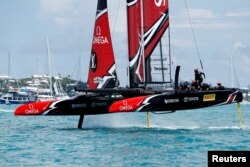From water taxis that "fly" on hydrofoils to aircraft wings and cutting-edge car steering wheels, the America's Cup has produced technology with potential far beyond its "foiling" catamarans.
With their focus on carbon fiber and aerodynamics, the teams that fought for the America's Cup attracted partners including planemaker Airbus and automotive groups BMW and Land Rover who were keen to learn from them.
One area where this is likely to have an impact is in harnessing "foiling" technology, where the America's Cup boats "fly" above the water on foils, cutting water resistance.
"Foiling in small electric boats will most likely appear on rivers in major cities. We are just at the beginning of the foiling adventure," Pierre Marie Belleau, head of Airbus Business Development, who managed its partnership with Larry Ellison's Oracle Team USA, told Reuters.
The space-age catamarans used in the 35th America's Cup, which ended in victory for Emirates Team New Zealand this week, can sail at maximum speeds of 50 knots (92.6 kilometers per hour) and have more in common with flying than sailing.
For Jaguar Land Rover, which sponsored British sailor Ben Ainslie's attempt to win the cup, the relationship is a strategic one with a focus on technology and innovation.
"We don't just get our logo onto a sail," Mark Cameron, the company's Experiential Marketing Director, said by telephone, adding that the carmaker would be providing more designers to help Land Rover BAR with technology for their next campaign.
Land Rover produced a special steering wheel for Ainslie to use in the America's Cup, with in-built gear shift paddles that allowed him to adjust the catamaran's "flight" levels.
The relationship is similar between BMW and Oracle Team USA, with the German automaker focused on areas including the electronics in the wheel used by skipper Jimmy Spithill, the development of carbon fiber used to make the boat and its components, and the aerodynamic testing.
"We like to think of ourselves more as a partner than a sponsor. We have a very strong carbon fiber relationship," Ian Robertson, who is the BMW management board member responsible for sales and brand, told Reuters between races.
"This is a dynamic sport that is developing fast. ... It's moving quickly just like the car industry is moving quickly. It's all changing," Robertson said.
Plane sailing?
The America's Cup catamarans use similar aerodynamics and load calculations to power their wings as commercial aircraft, which has led some skippers such as Spithill to become pilots.
Airbus is now considering applying the design and method of Oracle's foils to the tips of aircraft, Belleau said, adding that this would need a two- to four-year certification process and require it to change its production method.
Airbus has also created a new generation of Micro Electro Mechanical Systems (MEMS) microchips that were originally developed for the wings of its test aircraft and then adapted on board the Oracle boat to measure the wind speed and direction at all points on its almost 25-meter-high wing sail.
The sensors make it easier to tell if the wing sails are set efficiently, as wind speed and direction can vary from the top to bottom of the 25-meter wing of the America's Cup boats — technology that could become standard in the marine leisure industry to replace less reliable wind instruments.
"I would be very surprised if this MEMS technology does not become standard in order to replace the classic anemometer," Belleau said.
The Airbus A350-1000, one of Airbus' twin-aisle, wide-body jetliners, is also flying every day using new instrumentation developed through the partnership.
Oracle used Airbus' 3D printing and manufacturing process to produce stronger and lighter parts that Airbus has started to use on aircraft to replace titanium and aluminum.
"In 10 years from now ... this technology will spread and will be on all the sailing boats in the market," Belleau said. "In addition to the sporting competition, there is still this technological competition. ... The story is not finished."







